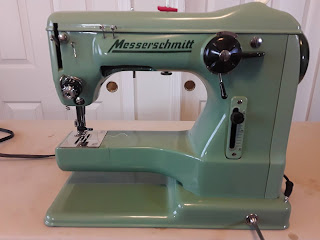Remember Willy Messerschmitt? The guy known for creating aircraft for the Germans in WWII? Well, guess what he and his company were up to after the war... Messerschmitt produced some odd looking vehicles (in that same green color), and some sewing machines!
This Messerschmitt is very light compared to machines of its era. It's made of aluminum and has a lot more open space within it than other machines, making it very light. If it had wings, the machine would fly!
I'm sure many Singer fans would instantly recognize certain styling that is reminiscent of the Singers of the early 1950s, but there are several features that Messerschmitt added which make this a unique machine. Let's check it out...
The Messerschmitt comes in its own suitcase. Ready for adventures!
Let's open the suitcase and see what's inside....
A pocket for holding the manual & attachments. The machine is strapped in and is nestled inside its wooden sewing table, ensuring that it doesn't slide around within the case.
The wooden sewing table in the case. This is a reproduction of the original - our Messerschmitt didn't come with a sewing table, but we have a good friend who is into woodworking who recreated the sewing table similar to the original. He included features which hold the knee lever in place and which ensure that the machine's stitch selectors are not damaged.
All set up on the table with its knee lever engaged for sewing.
Close up of the front of the machine. Lovely industrial green color.
Top view. Check out the stitch selectors. You push a combination of the levers to the left to generate various stitch patterns.
Side view of the machine. You can see the bobbin winder and the light switch.
These are the stitch selectors. You can move them up one at a time for a specific stitch, or move up multiple levers for a combination stitch. You need a stitch design decoder to determine which selections to combine to create specific stitches...
Back side of the machine.
Official tag on back of machine. Made in Germany.
Left side of machine with official Messerschmitt logo. This is also the logo you would see on the Messerschmitt planes.
Machine with its sewing table in place.
Front view of machine with its sewing table. My woodworker friend chose very nice wood for this project.
Top view showing the lovely wood grain and the fun selector switches.
The official attachment container. It's a rather stiff plastic fabric with the Messerschmitt label engraved.
Interior of the attachment container. Huzzah! We have many original attachments. Many closely resemble Singer attachments. I haven't tested to see if they are interchangeable with Singer attachments, but they look as if they ought to fit. Will have to test some day and report back on it.
Close up of the attachments. Note the extra bobbin case I have. The knob across the front of the bobbin case helps hold the bobbin in place. Everything looks very similar to Singer attachments of the same era.
This is the other half of the attachment case. The oil container is empty, but I'm glad that the original owner didn't throw it away when the oil ran out because it has the Messerschmitt logo on it. There is also a pair of brushes, a wrench, and two screwdrivers for opening the case as needed.
Stitch sample. I'm not sure how old it is, but the fabric looks pretty old. The mostly straight stitching on the right was done by me when I was testing the machine in an attempt to check the tension.
The official manual. Thankfully, although it's from Germany, the manual is in English. There are a few inserts in German, but the rest is in English.
The "Secret decoder ring" for stitch combinations. No, I haven't figured it out yet, but I have ideas for how to work with it. I don't often use decorative stitches, so in general I won't need it, but it's great that I have the thing to help with it if I choose to try some interesting stitch combos.
HAPPY SEWING!!



























No comments:
Post a Comment